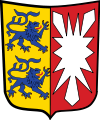- House of Glücksburg
-
Not to be confused with Schleswig-Holstein-Sonderburg-Glücksburg (elder line).
House of
Schleswig-Holstein-Sonderburg-GlücksburgCountry Germany, Denmark, Norway, Greece and Iceland Ancestral house House of Oldenburg Titles Duke of Schleswig-Holstein, King of Denmark, King of Norway, King of the Hellenes, and King of Iceland Founder Friedrich Wilhelm, Duke of Glücksburg Current head Christopher, Duke of Schleswig-Holstein Founding 1825 Christoph, Duke of Schleswig-Holstein, current head of the House of Glücksburg and the entire House of Oldenburg
The House of Schleswig-Holstein-Sonderburg-Glücksburg (Danish: Slesvig-Holsten-Sønderborg-Lyksborg, the latter name is also spelled Glücksborg), known as the House of Glücksburg (or House of Glücksborg) for short, is a German ducal house, junior branches of which include the royal houses of Denmark and Norway, the deposed royal house of Greece, and the heir to the thrones of the Commonwealth realms[1][2] (although in the latter case, they are, by royal proclamation, declared to be members of the House of Windsor[3]). The family is named after Glücksburg in northernmost Germany, and is a cadet branch of the House of Oldenburg that is descended from King Christian III of Denmark. However, as the elder line of the House of Oldenburg became extinct in the 19th century, the House of Glücksburg is now the senior surviving branch of the House of Oldenburg.
This particular line comes from the Dukes of Schleswig-Holstein-Sonderburg-Beck. The last of them became Duke of Glücksburg and changed his title accordingly to Friedrich Wilhelm, Duke of Schleswig-Holstein-Sonderburg-Glücksburg. He was married to Princess Louise Caroline of Hesse-Kassel, a granddaughter of King Frederick V of Denmark.
Neither the Dukes of Beck nor of Glücksburg were sovereign rulers - they held their lands in fief to the sovereign dukes of Schleswig and Holstein (who were also the Kings of Denmark in personal union) and, before 1773, the Dukes of Holstein-Gottorp.
Christian IX of Denmark, the fourth son of Friedrich Wilhelm, was chosen by the childless King Frederick VII of Denmark to be his heir, as Christian was married to Frederick's first cousin, Luise of Hesse-Kassel. Wilhelm, the second son of Crown Prince Christian and Crown Princess Luise, was elected King of the Hellenes on March 30, 1863 to succeed the deposed Wittelsbach Otto of Greece and took the name George I of Greece. His father became King of Denmark as Christian IX on November 15, 1863. Prince Carl, the second son of Frederick VIII of Denmark, Christian IX's eldest son, became King of Norway on November 18, 1905 as Haakon VII of Norway. Christian IX's daughters, Alexandra of Denmark and Dagmar of Denmark (who became Maria Feodorovna), married Edward VII of the United Kingdom and Alexander III of Russia, respectively. As a result, by 1914, descendants of King Christian IX were nearly as prevalent on European thrones as those of Queen Victoria; Christian IX became known as the Father-in-law of Europe.
Contents
Male line ancestry of Duke Friedrich Wilhelm
- Elimar I, Count of Oldenburg
- Elimar II, Count of Oldenburg
- Christian I, Count of Oldenburg (Christian the Quarrelsome)
- Maurice, Count of Oldenburg
- Christian II, Count of Oldenburg
- John I, Count of Oldenburg
- Christian III, Count of Oldenburg
- John II, Count of Oldenburg
- Conrad I, Count of Oldenburg
- Christian V, Count of Oldenburg
- Dietrich, Count of Oldenburg
- Christian I of Denmark
- Frederick I of Denmark
- Christian III of Denmark
- John II, Duke of Schleswig-Holstein-Sonderburg
- Alexander, Duke of Schleswig-Holstein-Sonderburg
- August Philipp, Duke of Schleswig-Holstein-Sonderburg-Beck
- Frederick Louis, Duke of Schleswig-Holstein-Sonderburg-Beck
- Peter August, Duke of Schleswig-Holstein-Sonderburg-Beck
- Karl Anton August, Prince of Schleswig-Holstein-Sonderburg-Beck
- Friedrich Karl Ludwig, Duke of Schleswig-Holstein-Sonderburg-Beck
- Friedrich Wilhelm, Duke of Schleswig-Holstein-Sonderburg-Glücksburg
Senior line, Dukes of Schleswig-Holstein-Sonderburg-Glücksburg (1825–present)
For the earlier line of dukes, see Schleswig-Holstein-Sonderburg-Glücksburg (elder line).Ducal Family of Schleswig-Holstein - HH The Prince
HH The Princess- HH The Hereditary Prince
- HH Princess Sophie
- HH Prince Constantin
- HH Prince Leopold
- HH Princess Marita
- HH Prince Alexander
- HH Princess Helena
- HH Prince Julian
- HH Princess Ingeborg
Extended family









